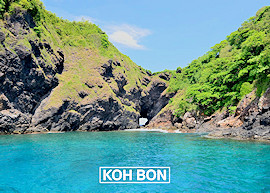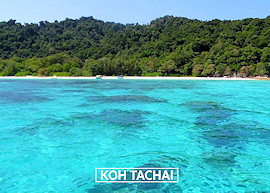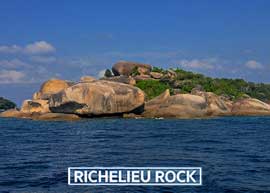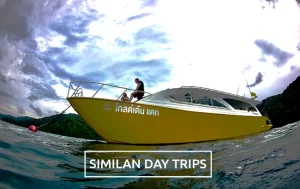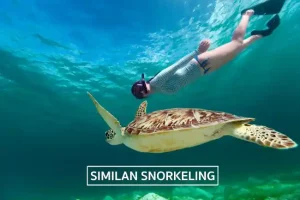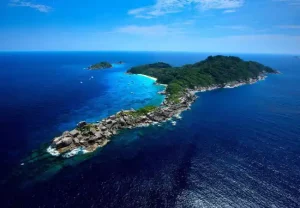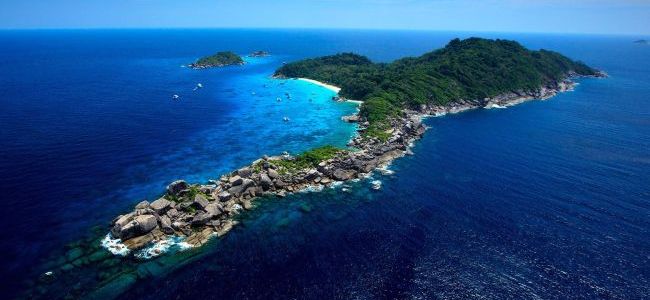
Similan Islands offer crystal clear waters and a spectacular marine life and therefore it is no surprise that the best scuba diving liveaboard cruises and daytrips take part in this area. The Similan Islands are a Marine National Park and consist of 11 islands and are located off the west coast of Thailand, 70 km west of Khao Lak. The Similan Islands eastern coast offers sloping coral reefs where as the west coast has huge granite boulders with amazing swim-throughs.
The Similan Marine National Park is open from the 15th October until the 15th May every year and is the most popular scuba diving destination in Thailand.
Similan Islands Dive Sites
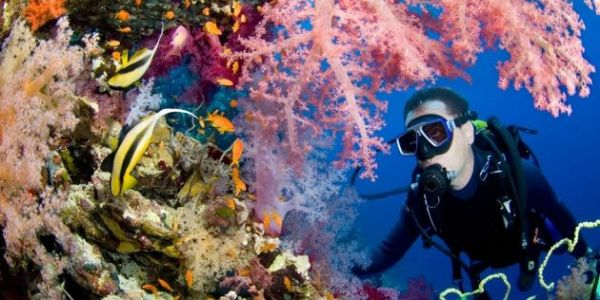
Anita’s Reef is located between 2 islands: from the south-eastern tip of island 6 it runs around the east side of island 5. A site comprising of granite boulders spread down the east cost of these 2 islands with flat sandy areas inbetween. On the southeast tip of island 5 is a rocky outcrop providing the perfect habitat for small critters and beautiful corals.
Anita’s Reef teems with marine life and coral. A huge variety of fish swim between hard and soft corals, staghorn corals and seafans. Here divers can often catch sight of Razor wrasse, Angle fish, Trevally and Pipefish. On the bottom of the seabed an encounter with an Octopus or Seasnake is possible and Stingrays and Leopard sharks are not uncommon here too. Depths reach from as shallow as 5 metres to as deep as 40 metres with visibility between 20 and 40 metres. Currents here are mostly mild so this site is suitable for all divers and especially beginners.

Breakfast Bend is one of the most popular dive sites in the Similans, with boulders dotted around the sea bed it hosts a wealth of marine life and a huge variety of coral. Located just east of island 8, this is an excellent dive site and many say that it has some of the best reefs in the area. Scattered with colourful hard corals, staghorn coral and sea whips, Breakfast Bend is home to Leopard sharks and Turtles.
Lucky divers might come across Whitetip reef sharks on the sea bed or catch sight of a passing Khul’s ray or find a Ghost pipefish swimming by. Breakfast Bend ranges in depth from 0 metres to 35 metres, the visibility here is usually very good ranging from 10 to 30 metres. Currents here are medium so the dive site is suitable for everyone including beginners.
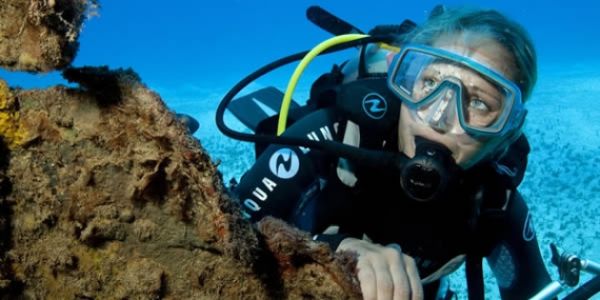
Another dive site situated amongst the typical Similan Island large boulders, Deep 6 offers many large and small swim throughs. This site has been named ‘Deep 6’ due to the fact that it actually used to be off sland 6, since the renaming of the islands it sits off the north of point of island number 7.
The large boulders offer shelter on one side and also provide the dark cracks and spaces that Pipefish love to hide in. Deep 6 is a popular site for seeing trevally and there are often barracuda and white tip reef shark passing by. Deep on the sea floor Harlequin and Mantis shrimp can be found.
The site is known for its hard stone corals, sea fans and soft corals. Depths at Deep 6 reach between 10 and 40 metres down and visibility can be anything form 10 to 30 metres.
This is one site where there is the opportunity to look out into the blue. Currents can be strong on one side of the boulders so this site is recommended for confident and experienced divers.
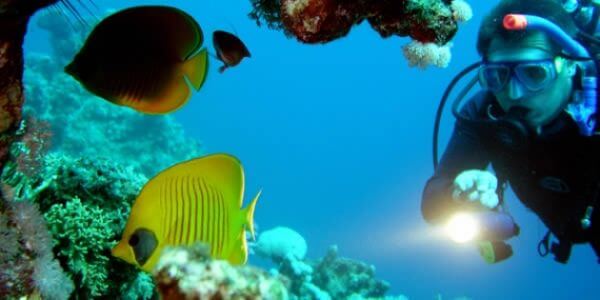
Elephant Head Rock is appropriately titled due to it’s strangely shaped granite rocks that protrude from the water and give the appearance of an elephant below the water’s surface. These classic Similan boulders create swim throughs and tunnels making this one of the most interesting dive sits in the Similan Islands. Elephant Head Rock is located off the south west tip of island 8.
On this dive site underwater explorers are greeted by a variety of fish and marine life. Parrotfish, Anglefish, Blue surgeonfish and Andaman sweetlips all inhabit this area. Hunting Barracudas often show themselves before they pounce on unsuspecting prey and Elephant Head Rock is renowned for small reef shark who feed here.
Lucky people could even encounter a Manta ray or on rare occasions it’s possible to see a Whale shark. Depths here are between 5 and 40 metres with visibility good to great between 15 and 40 metres. The currents here can often be strong, but the large boulders provide protection making this a dive site best suited for confident and experienced divers.
DIVE SITE INFORMATION
Depths here are between 5 and 40 metres with visibility good to great between 15 and 40 metres. The currents here can often be strong, but the large boulders provide protection making this a dive site best suited for confident and experienced divers.
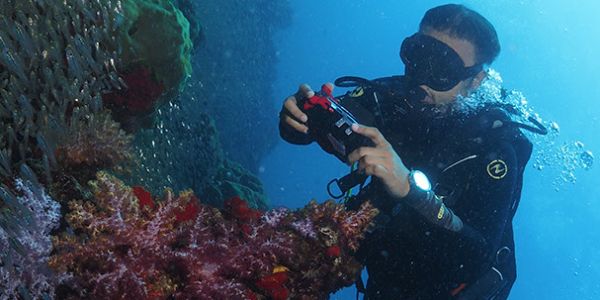
Named after 3 distinct trees on Island 9 who marking the jumping point for the dive, this is often one of the highlights of the trip. Displays a large cluster of sloping boulders from 17m to well over 40m.
Often considered the best chance of Leopard Sharks , there are also Long Fin Bat Fish, Napoleon Wrasse, Unicorn Fish, and groups of Brown Marbled Grouper about. Heading across the sand to the main reef, you can see Kuhl’s Rays, Spotted Garden Eels, and sometimes Leaf Fish.
Please be aware as several times throughout the season both Yellow Margin and Titan Trigger Fish lay their eggs in the numerous ‘pits’ here. Highlights could include Banded Sea Kraits, schooling Yellow Fin Barracuda, Milk Fish, Hawksbill Turtles, and large groups of Big Eye Snapper. This is considered as a great reef for snorkelers too.
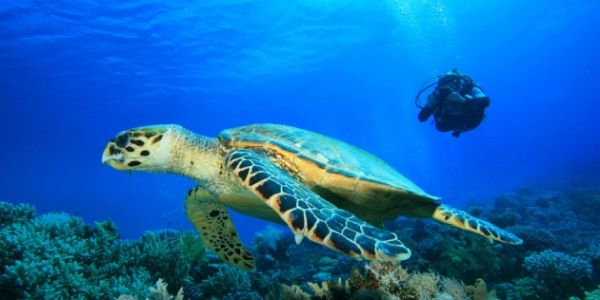
Turtle Rock is located just off the northeast of island 8 in the Similans, it is a convenient site for diving as it is near sheltered Donald Duck Bay. The site took its name from the shape of the rock near the island, which is also the home of some interesting sights beneath the actual rock itself. As with many Similan Island dive sites, Turtle Rock is comprised of large boulders that sit together under the water forming swim throughs.
Although there is not a lot of coral or much marine life at Turtle Rock, it is often the destination for Turtles, Snappers and Groupers. Long nose file fish can also be found here using their long snouts to search for food. At Turtle Rock depths can vary between 5 and 25 meters with good visibility from 15 to 20 meters. There is little current here so this site is suitable for every diver.
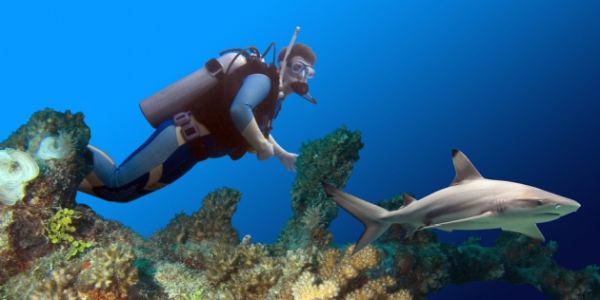
The popular dive site West of Eden is on the other side of island number 7 to East of Eden, and like many of the dive sites around the island it consists of large boulders. Soft coral dominate the site, but sea fans, sponges and gorgonians can also be found here too.
Interesting varieties of Pipefish and Nudibranches can be found in the crevices on the site wall, while larger marine animals can be found at the depths of the site. Giant trevally have been known to inhabit this area and white and black tip sharks are often sighted passing by.
West of Eden varies in depth from as shallow as 5 meters to as deep as 40. Currents can be strong, but it is still a suitable dive site for anyone from beginners to experienced divers.


